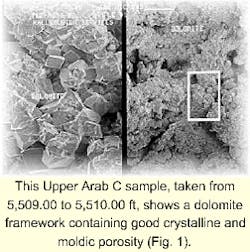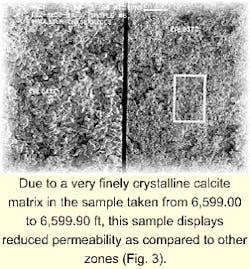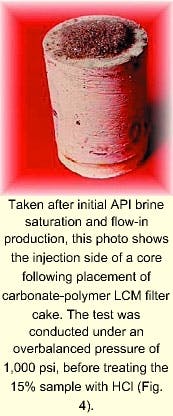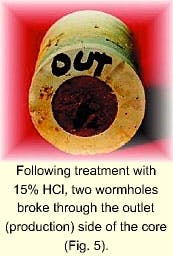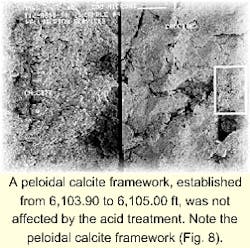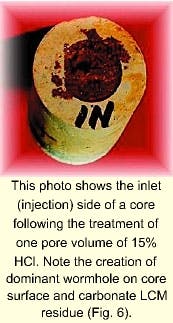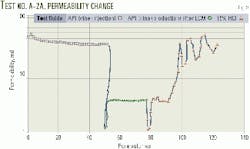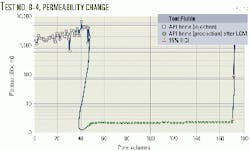Wells treated with calcium carbonate lost-circulation material induced permeability damage to formations in the Dukhan field of Qatar.
This occurred despite the promising application of this treatment in other fields where it has become common to seal off productive zones with viscous brines loaded with a nondamaging and acidable material (calcium carbonate).
Typical applications target the well-killing process for gas producers and water-dump flood injectors prior to the continuance of workover operations. The seal-off procedure uses a hesitation squeeze-off technique as wells are bull-headed with large volumes of high viscous brine loaded with degraded CaCo3 pills (Table 1).
This operation is conducted under a surface seal-off pressure of 1,000 psi.
Common practice
The seal-off condition required an average of 3 operational days utilizing large volumes of high-viscous brine pills and CaCO3. On occasion, treatment also required an acid dose of 500 gal/ft (gpf) to dissolve the pumped carbonates. Wells were continuously acidized with a dose of only 50 gpf before and after well production or injection.
Problems throughout the procedure included:
- Long clean up times.
- Plugged manifolds, valves, and flow lines.
- Wire line restrictions across nipples.
- Insufficient amount of acid dose usage as compared to theoretical volumes to remove lost-circulation material (LCM, CaCo3).
- Retrogressive well productivity or injectivity.
- High operational costs.
Testing
Technicians conducted laboratory tests to evaluate the potential for damage occurring from the application of LCM material. These tests also served to evaluate the acidizing techniques conducted throughout the damage removal process.
Six representative core samples were received from three zones within two formations, the Jurassic Arab C and Arab D. These carbonate formation cores were analyzed and petrographically classified with the following techniques:
- Qualitative X-ray diffraction, iron content, and acid solubility analyses.
- Permeability and porosity analyses.
- Fluid loss tests.
- Acid rotating disc tests.
- Rock property tests.
- Water analyses.
- Matrix injection test.
- Scanning electron microscope (SEM) and petrographic examination.
In addition to the core samples, technicians analyzed two dry granular LCM samples, one blended viscous LCM pill sample, and one formation water sample.
The upper Arab C cores consist of dolomites and are classified as anhydrite bio-dolosparites based on petrographic criteria. The lower Arab C cores consist of limestones and are classified as dolosparite and dolomitic bio-micrite. Corresponding HCl solubilities of the formation samples range from 74.5 to 100% and contain very low amounts of soluble iron.
Calcite and dolomite ratios correspond very well with the petrographic classifications and appear constant for each microfacies.
Figs. 1 and 2 (Upper Arab C) contain significant amounts of anhydrite (15-20%) and minor clays. All other samples consist of relatively pure carbonates. Overall, these samples contain high visual and measured porosities. Additionally, samples indicated high overall air permeabilities with the exception of the biomicrite microfacies represented in Fig. 3.
Porosity and permeability characteristics typically result from well-developed secondary dissolution pores, which are very large in size as observed by petrographic and SEM photomicrographs.
Based on the observed formation characteristics, it is reasonable that large volumes of fluid would be lost in this formation during the workover procedure, and it is quite probable that the LCM filtrate and some particles would penetrate into the formation matrix under conditions of overbalance experienced in the area.
In order to quantify the LCM leak-off characteristics and evaluate compressibility of water (Cw) and spurt loss values, technicians performed fluid-loss tests with samples from each of the three zones. The cores were first saturated with API brine followed by the LCM under an overbalanced pressure of 1,000 psi to obtain fluid loss data.
Tests indicated fluid-loss control was achieved with no spurt loss. Thus, filtrate volumes would be lost if control were needed for a long period of time. A result of packed carbonate particles and partially dehydrated gel residue, the resulting filter cakes also showed a tenacious behavior (Figs. 4-6).
Using the acid rotating disc method at 150° F., technicians tested the effects of formation saturation with an LCM carrier gel in reaction to 15% HCl. To compare "after fluid loss" values with "before fluid loss" values, they then compared end pieces from the same core samples.
Technicians noted lower reaction rate constants (Fig. 2). Moderate differences were seen in Fig. 7. Fig. 8 was not significantly affected.
To evaluate the effects of the LCM pill on formation damage and LCM removal strategy, technicians conducted a series of specifically designed matrix core flow tests. In each of the tests, an initial single-phase API brine flow was established prior to spotting the LCM material at the face of the core under an overbalance of 1,000 psi for 12 hr. Results from one test, before and after, are shown in Figs. 9 and 10.
Test A-2A showed damage of about 90% after back flow in the production direction using API brine. Returning the original permeability in this lower permeability sample to normal required a relatively large volume of HCl.
As the sample was extremely soluble in HCl, this poor response showed surprising results. Much higher and more rapid response to HCl via wormhole formation would have been expected.
Test B-4 was performed in a similar fashion, except technicians increased the API brine flow following LCM injection to illustrate the poor cleanup characteristics from brine injection (Fig. 9).
During this procedure, almost 100% damage occurred from the LCM pill prior to HCl treatment. In addition, technicians conducted the clean-up stage with 15% HCl by first circulating acid across the core face and then soaking the sample prior to core injection.
Only one pore volume of acid was injected before the wormhole breakthrough occurred. This seems to indicate that the acid acted to create the wormhole with minimal spending on the core matrix, thus indicating damage bypass.
Because tests using the carbonate formation core could not quantify the amount of residual damage from the LCM in the core matrix, following the HCl acid treatment process, technicians used a high permeability, non-HCl soluble ceramic filtrose core.
In this test, HCl injection was performed immediately after spotting the LCM pill. This was followed by API brine in the same (injection) direction then flow reversal (production direction). Results of this test show poor matrix damage removal with HCl and low initial injectivity. The test also shows 97% damage in the injection direction following the acid treatment and 93% damage after flow reversal.
In summary, without damage bypass through wormhole propagation, severe matrix damage will remain high despite high volumes of HCl. Even though the carbonate particles in the LCM filter cake appear to dissolve, severe matrix damage still remains behind even if the LCM material remains in contact with HCl.
It appears as though sufficient acid volumes will remove the LCM filter cake; however, contact may be very difficult due to the soluble nature of the formation. It is quite probable that perforations would be completely "packed" with the low-permeability, tenacious LCM material. Filter cakes observed in the lab, in fact, appeared similar to cement.
During the acid treatment, as shown by matrix flow tests, the acid quickly wormholes through the formation as soon as a pathway is created through the carbonate LCM. In a perforation, effective flow geometry may not be created if the acid flow path channels are parallel to the wellbore.
This cannot be determined quantitatively in the laboratory without simulating a "perforation tunnel." The effects of the viscous carrier fluid also cannot be quantified in regards to downhole invasion, although severe damage appears to occur in the invaded zone.
As a result, unless the damage is bypassed through wormholes or fracturing, significant damage would most likely remain. Without effective flow geometry in a filled, damaged perforation, or if complete zone coverage is not obtained, matrix acidizing may not provide an effective treatment.
Recommendations
Higher acid volumes than the 50 gpf are clearly justified. Also, the application of large-volumes of treatment during the job using appropriate soluble diverters may be worth considering.
The best solution, however, may include a small-scale fracture acid treatment designed to bypass damage if matrix injection is not successful. The only alternative may be to contact the LCM material with an acid matrix treatment.
Ultimately, the practice of using less-damaging LCM systems should be used to achieve maximum well performance. The objective should be to prevent invasion of damaging material into the large pore network of the producing carbonate.
Acknowledgment
The author thanks Halliburton Stimulation Research and Engineering Department for their contribution to this article.F
The author
Layth S. Al-Samarraie is a senior drilling engineer with Qatar General Petroleum Corp. He has 23 years of experience in drilling and workover operations in North Africa (Libya) and the Middle East (Qatar). Al-Samarraie holds a BS from Cairo University, Petroleum College.

